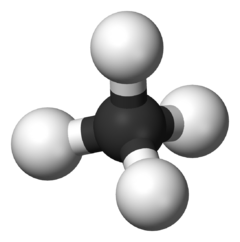Hydrocarbon
Appearance

A hydrocarbon is an organic compound consisting entirely of hydrogen and carbon.
Quotes
[edit]- Even though alkanes are relatively unreactive and rarely involved in chemical reactions, they nevertheless provide a useful vehicle for introducing some important general ideas.
- John McMurry, Organic Chemistry 8th ed. (2012), Ch. 3 : Organic Compounds: Alkanes and Their Stereochemistry
- Cyclic molecules are so commonly encountered throughout organic and biological chemistry that it’s important to understand the consequences of their cyclic structures. ... A cycloalkane is a saturated cyclic hydrocarbon with the general formula CnH2n. In contrast to open-chain alkanes, where nearly free rotation occurs around C-C bonds, rotation is greatly reduced in cycloalkanes.
- John McMurry, Organic Chemistry 8th ed. (2012), Ch. 4 : Organic Compounds: Cycloalkanes and Their Stereochemistry
- Bond homolysis in alkanes yields radicals and free atoms. The heat required to do so is called the bond-dissociation energy ... Its value is characteristic only for the bond between the two participating elements. Bond breaking that results in tertiary radicals demands less energy than that furnishing secondary radicals; in turn, secondary radicals are formed more readily than primary radicals. The methyl radical is the most difficult to obtain in this way.
- K. Peter C. Vollhardt, Neil E. Schore (2011) Organic chemistry : structure and function 6th ed. Chapter 3. Reactions of Alkanes
- When alkanes are heated to a high temperature, both C–H bonds and C–C bonds rupture, a process called pyrolysis. In the absence of oxygen, the resulting radicals can combine to form new higher- or lower-molecular-weight alkanes. Radicals can also remove hydrogen atoms from the carbon atom adjacent to another radical center to give alkenes, a process called hydrogen abstraction.
- K. Peter C. Vollhardt, Neil E. Schore (2011) Organic chemistry : structure and function 6th ed. Chapter 3. Reactions of Alkanes
- Breaking an alkane down into smaller fragments is also known as cracking. Such processes are important in the oil-refining industry for the production of gasoline and other liquid fuels from petroleum.
- K. Peter C. Vollhardt, Neil E. Schore (2011) Organic chemistry : structure and function 6th ed. Chapter 3. Reactions of Alkanes
- Alkanes lack functional groups, so they do not undergo the kinds of electrophile – nucleophile reactions typical of functionalized molecules. In fact, alkanes are pretty unreactive. However, under appropriate conditions, they undergo homolytic bond cleavage to form radicals, which are reactive species containing odd numbers of electrons. This is another situation in which the structure of a class of compounds determines their function.
- K. Peter C. Vollhardt, Neil E. Schore (2011) Organic chemistry : structure and function 6th ed. Chapter 3. Reactions of Alkanes
- The relative reactivities of the various types of alkane C–H bonds in halogenations can be estimated by factoring out statistical contributions. They are roughly constant under identical conditions and follow the order CH4 < Primary CH < Secondary CH < Tertiary CH ... The reactivity differences between these types of CH bonds are greatest for bromination, making it the most selective radical halogenation process. Chlorination is much less selective, and fluorination shows very little selectivity.
- K. Peter C. Vollhardt, Neil E. Schore (2011) Organic chemistry : structure and function 6th ed. Chapter 3. Reactions of Alkanes
- The discrepancy between calculated and measured heats of combustion in the cycloalkanes can be largely attributed to three forms of strain: bond angle (deformation of tetrahedral carbon), eclipsing (torsional), and transannular (across the ring).
- K. Peter C. Vollhardt, Neil E. Schore (2011) Organic chemistry : structure and function 6th ed. Chapter 4. Cycloalkanes
- The conformational analysis of cyclohexane enables us to predict the relative stability of its various conformers and even to approximate the energy differences between two chair conformations.
- K. Peter C. Vollhardt, Neil E. Schore (2011) Organic chemistry : structure and function 6th ed. Chapter 4. Cycloalkanes

